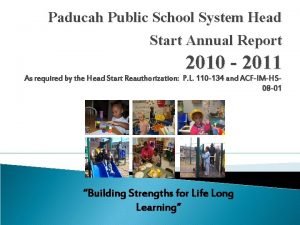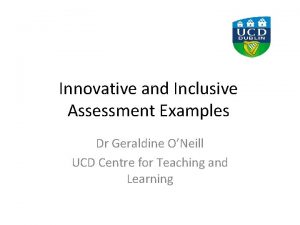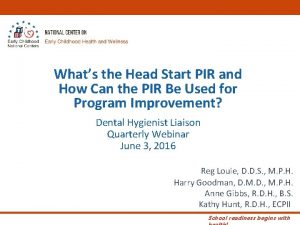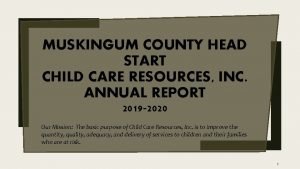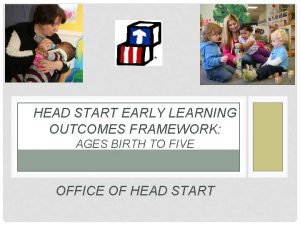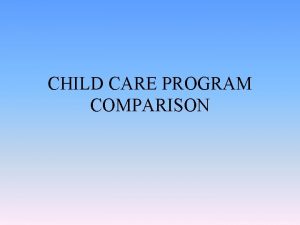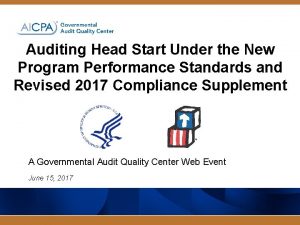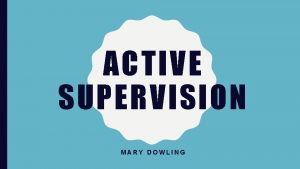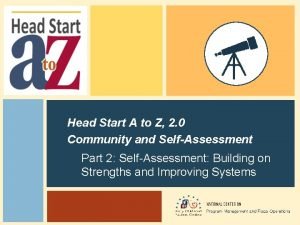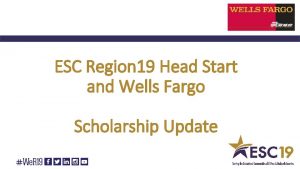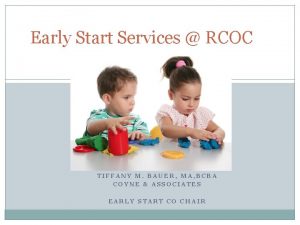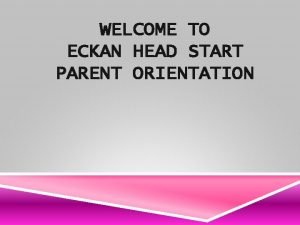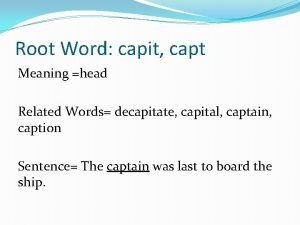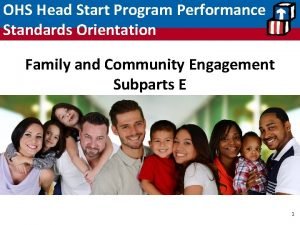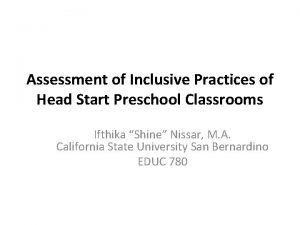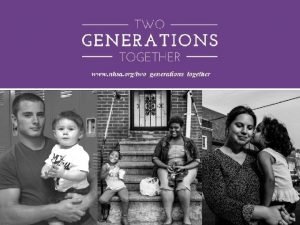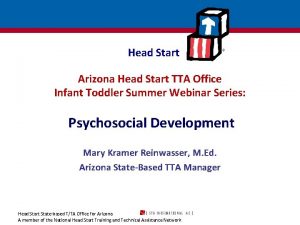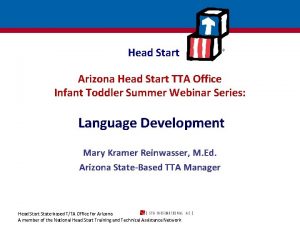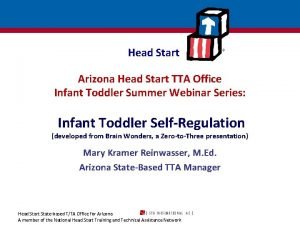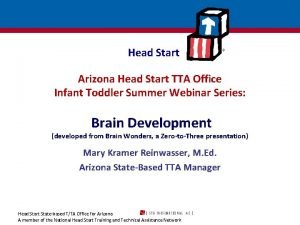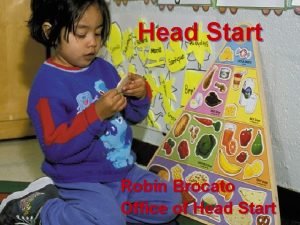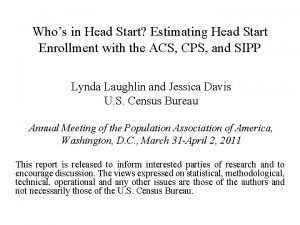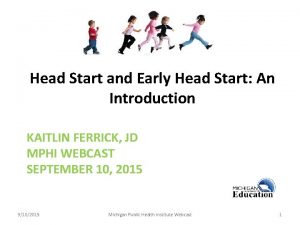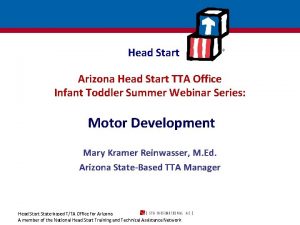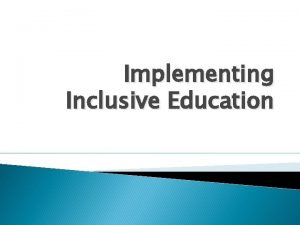Assessment of Inclusive Practices of Head Start Preschool















- Slides: 15

Assessment of Inclusive Practices of Head Start Preschool Classrooms Ifthika “Shine” Nissar, 3 rd Year Student Ed. D. Educational Leadership California State University San Bernardino

Introduction Head Start preschool program is the largest provider of inclusive services for children with special needs in the United States (Muccio et al. , 2014). In 1972, Public Law P. L 92 -424 mandated that 10% of the total students enrolled in Head Start preschool classrooms are reserved to serve students with special needs and their families (Allen & Cowdery, 2009). Currently the Head Start preschool program is not mandated to assess the quality of inclusive practices.

Significance of the Study The study has the potential to transform inclusive practices of Head Start preschool classrooms. Research findings will be contributed to the current literature. Research on the assessment of inclusive practices within Head Start preschool classrooms is extremely scarce in the current literature.

Literature Review Theme 1 - Historical Context of the Problem: Research Problem Theme 2 - Head Start Preschool Program: Laws and Regulations, Benefits of Head Start, Student Outcome Assessments – Desired Results Developmental Profile (DRDP) Theme 3 – Inclusive Practices in Early Childhood Preschool Classrooms Theme 4 – Assessment of Inclusive Practices Early Childhood Preschool Classrooms I. Current Assessment of Inclusive Practices of Head Start Preschool Classrooms II. Assessment of Inclusive Practices Using the Inclusive Classroom Profile (ICP) III. Teacher Education, Knowledge and Skills of Preschool Inclusive Practices Theme 5 - Professional Development to Support Inclusive Practices

Setting and Subjects The study will be conducted in 10 Head Start preschool classrooms in Riverside County. Research participants will be identified via purposeful sampling (Creswell, 2013; Saldana 2013) method. ◦ Classrooms must have at least two students with special needs with an Individualized Education Plan (I. E. P). Preferably other than for speech and language services. ◦ Teachers who have served as Head Start teachers for at least 5 years and have served students with I. E. Ps for at 2 least years. ◦ Program Directors who have served as Directors for at least 1 year 150 preschool students (out of which at least 15 students with an identified disability and an Individualized Education Plan (I. E. P). The researcher will assign pseudonyms to protect the institutions and participants of the study.

Data Collection § Inclusive Classroom Profile (ICP) assessment data will be collected during spring 2016. § Archived student outcome data from the Desired Results Development Profile (DRDP) from fall 2014 and spring 2015 semesters will be analyzed. § Program Directors, Teachers and Teacher’s Assistants will complete the Support Scale for Preschool Inclusion (SSPI) Survey ( Küçüker, S. , Funda A. , & Emine G. 2006).

Enrollment of children with and without special needs nationwide and statewide Enrollment of Students in Head Start Preschool Classrooms Nationwide California All Students 759, 110 87, 043 Students with Special Needs 130, 690 14, 646 Source: National Head Start Fact Sheets, 2014, National & California

Enrollment of Children with Special needs in Riverside County

Research Design - Quantitative Tools – research Inclusive Classroom Profile (Soukakou, 2012) Desired Results Developmental Profile (California Department of Education, 2013) Support Scale for Preschool Inclusion (SSPI) Survey (Küçüker S. , Funda A. , & Emine G. 2006) Methodology – Correlational data will be analyzed by identifying observable variables by implementing Analysis of Variances (ANOVA), Path Analysis of Structural Equation Modeling (SEM) (Tabachnik & Fidell, 2012) methodology with the use of the LISREL software.

Research Question(s): 1. How have inclusive practices within Head Start classrooms impacted student performance for a) students with disabilities? b) students without disabilities? 2. Are scores on ICP correlated with outcome data of the DRDP for a) students with disabilities? b)students without disabilities? 3. Does the ICP predict student performance outcomes for a) students with disabilities? b)students without disabilities? 4. Does the SSPI predict student performance outcome for a) students with disabilities? b)students without disabilities? 5. Are the ICP and SSPI related to each other or look at completely different variables?

Research Hypothesis: High quality inclusive practices have a positive impact on student performance for student with and without special needs. Null Hypothesis: The quality of inclusive practices does not have an impact on student performance for student with and without special needs. Independent Variable: Inclusion in Head Start as measured by the Inclusive Classroom Profile (ICP) Dependent Variable(s): Student performance/outcomes as measured by the Desired Results Development Profile (fall and spring semesters)

Findings and Conclusion As a result of this research study, findings will contribute qto the current inclusive practices of Head Start preschool classrooms qto transformative changes of the assessment of inclusive practices (i. e. professional development trainings, use of ICP to measure inclusive practices… etc. ) qto the and literature on the assessment of Head Start inclusive practices

Questions? Thank you! nissari@coyote. csusb. edu

References Allen, K. E. , & Cowdery, G. E. (2009). The exceptional child: inclusion in early childhood education (7 th edition. ). Belmont, CA: Cengage Learning. California Department of Education. (2009). Inclusion works! creating child care programs that promote belonging for children with special needs. Sacramento, CA: California Department of Education. Cook, R. , E. , Klien, D. M. , & Chen, D. (2012). Adapting early childhood curricula for children with special needs (8 th edition. ). Upper Saddle River, NJ: Pearson. Creswell, J. W. (2012). Qualitative inquiry and research design: choosing among five approaches (3 rd edition. ). Los Angeles: SAGE Publications, Inc. Desired Results for Children and Families. (2013). Retrieved January 02, from http: //www. desiredresults. us/index. htm Küçüker, S. , Funda A. , & Emine G. (2006) "The development and psychometric evaluation of a support scale for pre‐school inclusion. " Early Child Development and Care 176(6) 643 -659. Muccio, L. S. (2012). Head Start instructional professionals’ perceptions and practices: facilitators and barriers for including young children with disabilities (Doctoral Dissertation). Retrieved from http: //search. proquest. com. libproxy. lib. csusb. edu/ Muccio, L. S. , Kidd, J. K. , White, C. S. , & Burns, M. S. (2014). Head Start instructional professionals’ inclusion perceptions and practices. Topics in Early Childhood Special Education, 34(1), 40– 48.

References Odom, S. L. , & Diamond, K. E. (1998). Inclusion of young children with special needs in early childhood education: The research base. Early Childhood Research Quarterly, 13(1), 3– 25. Odom, S. L. , Buysse, V. , & Soukakou, E. (2011). Inclusion for young children with disabilities: A quarter century of research perspectives. Journal of Early Intervention, 33(4), 344– 356. Riverside County Office of Education (2015). Head Start Annual Report. Retrieved May 13, 2015, from http: //www. rcoe. us/children-family-services/files/2014/03/2012 -2013 -Head-Start-Annual-Report-for-Web-Final. pdf Sandall, S. , Hemmeter, M. L. , Smith, S. J. , & Mc. Lean, M. E. (2006). DEC recommended practices: A comprehensive guide for practical application in early intervention/early childhood special education. Missoula, MT: Division of Early Childhood (DEC). Saldana, J. , (2013) The coding manual for qualitative researchers (2 nd edition). London: Sage Publications. Soukakou, E. P. (2012). Measuring quality in inclusive preschool classrooms: Development and validation of the Inclusive Classroom Profile (ICP). Early Childhood Research Quarterly, 27(3), 478– 488. doi: 10. 1016/j. ecresq. 2011. 12. 003 Tabachnik, B. G. , & Fidell L. S. (2012). Using multivariate statistics. (6 th Ed. ). New York. Allyn & Bacon.
 Paducah head start preschool
Paducah head start preschool Inclusive assessment examples
Inclusive assessment examples It's gotta start somewhere it's gotta start sometime
It's gotta start somewhere it's gotta start sometime Jumpstart pediatric triage
Jumpstart pediatric triage Whats head start
Whats head start Muskingum county head start
Muskingum county head start Head start early learning outcomes framework
Head start early learning outcomes framework Laboratory schools advantages and disadvantages
Laboratory schools advantages and disadvantages Notice of federal interest
Notice of federal interest Head start active supervision poster
Head start active supervision poster Head start management systems wheel
Head start management systems wheel Region 19 head start
Region 19 head start Bauer head start
Bauer head start Head start parent orientation
Head start parent orientation Words with the root capit meaning head
Words with the root capit meaning head Head start performance standards 1302
Head start performance standards 1302
